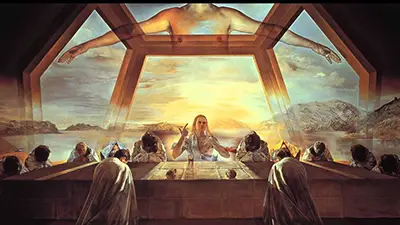He began to explore a combination of Catholic iconography and a philosophical view of quantum mechanics referring to this period himself as Nuclear Mysticism.
The Sacrament of the Last Supper an oil on canvas completed in 1955 after nine months work was one of his most iconic religious paintings of this era following on from Christ of St John of the Cross (1950) and Assumpta Corpuscularia Lapislazulina (1952) and later Crucifixion (1954).
The imposing canvas depicts Christ and the twelve apostles perhaps at the moment where he has declared "One of you will betray me". While not a historical rendering of the event but rather a depiction of the Eucharist itself, the apostles hide their faces whether in shock, disbelief, grief or prayer is hard to decide and a large torso with arms outstretched arches over the scene.
The translucence of the figures of both Christ and the figure above hint at the joining of both God and man in the sacrament while the shape of the room suggests an almost space age building hovering by the Sea of Galilee with its fishing boats.
The banker Chester Hale who was given first refusal of the painting bought it on first sight and donated it to the National Gallery of Art in Washington the following year where it immediately became the most popular work on display.
Although not appreciated by the critics who perceived his renewed Catholicism as insincere and the art which derived from it as lacking the creative genius of his earlier works, or indeed by the gallery who relegated it to an out of the way corner, the painting was loved by the American public.

